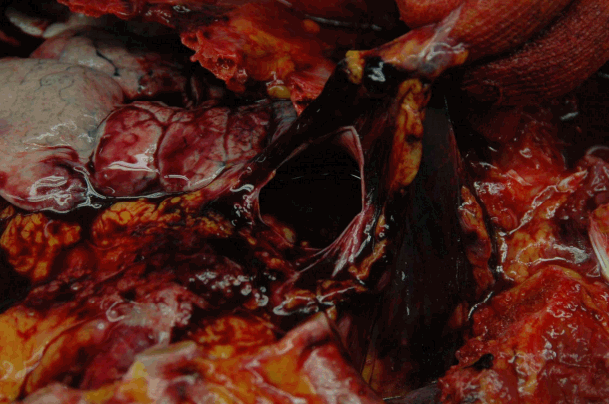Rupture of the Right Atrium Following a Closed-Chest Cardiac Massage
Article information
Abstract
Cardiac rupture is a rare complication of CPR but is usually fatal when it occurs. Here we report a 59-year-old woman who developed cardiac rupture which was caused by a fracture of the sternum and ribs associated with closed-chest cardiac massage.
CASE
A 59-year-old female presented to the emergency department due to stab injury on her left thigh. Cardiopulmonary resuscitation had been performed on the way to hospital by an Emergency Service Team due to cardiac arrest. Upon arrival at the emergency department, her initial Hemoglobin was 4.5 g/dl, ECG showed asystole, and the sternum was fractured due to the closed-chest cardiac massage. Postmortem examination revealed a fracture of the sternum and multiple ribs, approximately 300 ml of fluid blood in the pericardial sac (Fig. 1.), and a 2 × 2-cm-sized free perforation in the right atrium (Fig. 2.). There was no tear in the pericardium.

After opening the pericardial sac, a large amount of fluid blood was observed (The sternum was removed, and the pericardium was opened).
DISCUSSION
Since its introduction in the 1960’s, there have been many complications resulting from closed-chest cardiac massage including regurgitation, aspiration, and rib and sternal fractures [1]. Cardiac rupture is a rare complication of CPR however it is usually fatal when it occurs. Early diagnosis and treatment is a very important factor for positive prognosis [2]. While direct cardiac injuries resulting from penetration are usually readily recognized and appropriately handled, the etiologic relation of non-penetrating and indirect cardiac injuries are often overlooked, either at the time of injury or when complications are latent [3].
Cardiac rupture is a rare complication of CPR [4-6]. Blunt cardiac trauma, with an estimated incidence of 0.1%, can cause a cardiac rupture, cardiac contusion or commotio cordis [3]. Twenty-one percent of the patients had at least one complication because of CPR. Postmortem examination revealed cardiac rupture or pericardial hematoma related to CPR in 8% of unsuccessfully resuscitated subjects [7, 8].
Several factors are involved in the development of complications related to CPR such as age, build of the patient, duration of resuscitation, and skill of the emergency medical technicians. The time spent on resuscitation also contributes to the development of complications [5]. Cardiac rupture is caused by direct penetration of the fractured sternum or ends of fractured ribs [5,6,9,10]. In our case,
Permanyer et al. [10] reported a right atrium traumatic rupture presenting as chronic tamponade after CPR. Postmortum findings revealed a 2 × 3-cm-sized rupture of the base of the right atrium.
An autopsy revealed a fracture of the sternum and multiple ribs, about 300 ml of blood in pericardial space, and about a 2 × 2-cm-sized free perforation in the right atrium. A large amount of blood in pericardial sac can cause pericardial tamponade.
In this patient, the cause of rupture of the right atrium is likely related to closed-chest cardiac massage, and the cause of death was pericardial tamponade. Therefore, vigorous CPR performed in cardiac arrest can result in a lethal cardiac rupture and tamponade.
Notes
Conflict of Interest Statement
None of authors has a conflict of interest.
